A Step-by-Step Guide to Using AI for Effective Influencer Marketing
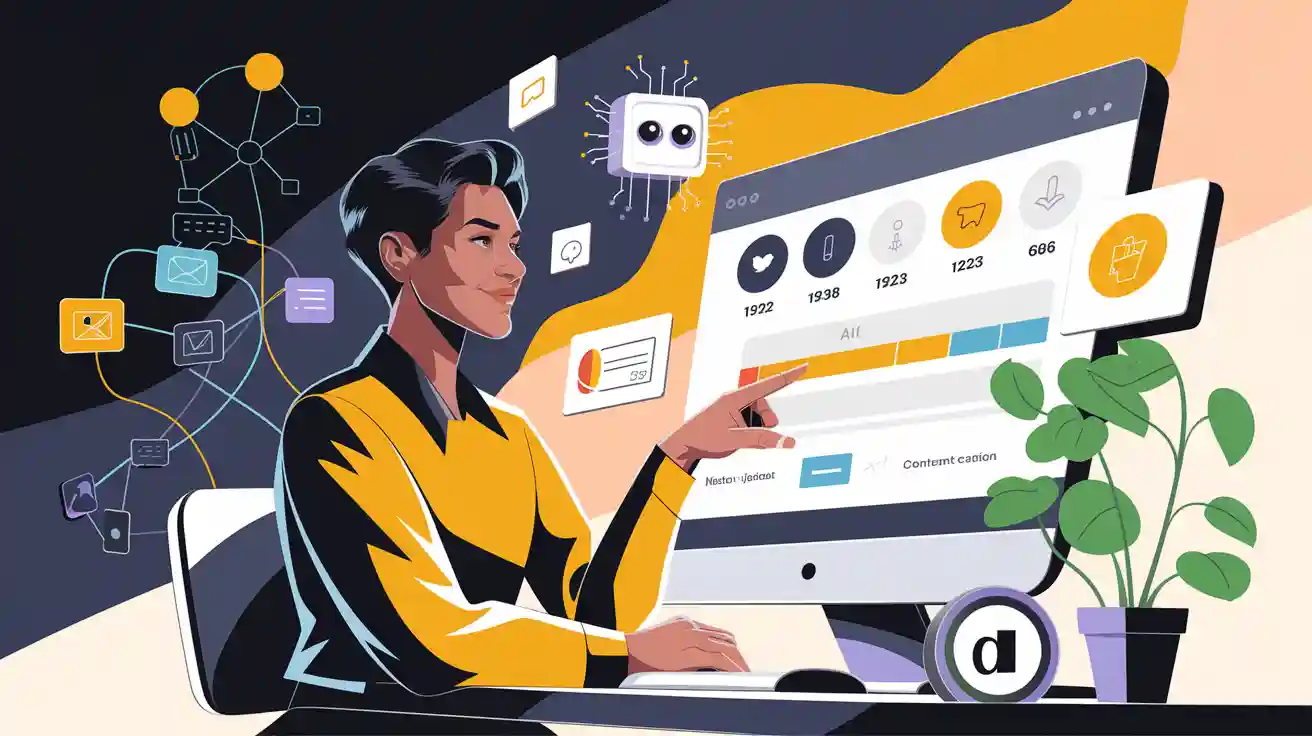
Influencer marketing is getting bigger, but it can be hard to find the right people and see if you are doing well. AI-powered influencer marketing uses data to help you pick influencers who match your goals. With AI, you can find fake engagement, guess campaign results, and change your plans quickly. The table below shows how AI makes influencer marketing work better and helps you earn more money:
Statistic | Description |
|---|---|
Brands already using or open to AI in influencer marketing | |
Up to 20% | Higher conversion rates with AI-driven personalization |
Up to 30% | Better marketing efficiency from AI data models |
Challenges in Influencer Marketing
Opacity and Inefficiency
Influencer marketing can be confusing and hard to track. Some platforms hide posts with tags like #ad or “paid partnership.” This is called “shadowbanning.” It makes it hard to see how well your posts do. Brands must follow rules about sponsorships. These rules can make fewer people see your posts. Platforms change their rules often and do not warn you. Your results can drop suddenly. It is hard to know if you are getting your money’s worth. It is also tough to follow all the changing laws. If you work in different countries, the rules can be different. This makes things even more confusing.
Tip: Always read platform rules and check for updates. This helps you avoid losing engagement.
A study found that 70% of people care about honesty. If brands or influencers do not share sponsorships, people trust them less. If posts seem fake or too planned, people may stop watching.
Challenge | Evidence / Data | Example / Impact |
|---|---|---|
Data Opacity | 70% of consumers value transparency; lack of clear disclosures reduces trust | Overly scripted or inauthentic content alienates audiences |
Cross-border Barriers | 20% of 2023 campaigns faced scrutiny for non-disclosure, reflecting regulatory compliance issues | Risk of fines, platform bans, or loss of audience trust due to failure in disclosure |
Fake Engagement
Fake engagement is a big problem in influencer marketing. Some influencers buy fake followers or use bots. This makes their accounts look more popular than they are. Brands think they will reach more real people, but that is not true. For example, Anushree Jain shared that 58.5% of Instagram profiles in India have fake followers. This means over half of the followers might not be real. If you pay for a post to 100,000 followers, only a few hundred may be real people. This wastes your money and makes it hard to know if your campaign works.
You can spot fake engagement by looking at likes, comments, and shares. If an account has many followers but few likes or comments, it may not be real. Brands should care about real engagement, not just big numbers.
Challenge | Evidence / Data | Example / Impact |
|---|---|---|
Fake Engagement | 15% of 2023 influencer marketing budgets lost to fakes | A $5,000 post to 100,000 followers gets only 500 real actions |
High Costs
Influencer marketing can be very expensive. Brands spend thousands or even millions each year on campaigns. The 2025 Later report says spending reached $32.55 billion. Most brands keep or raise their budgets. Almost half increase them by more than 11%. Top influencers charge a lot per post. Mid-tier influencers with up to 500,000 followers may charge up to $12,500 per post. Macro-influencers can ask for $25,000. Mega-influencers like Cristiano Ronaldo may charge over $1 million for one post.
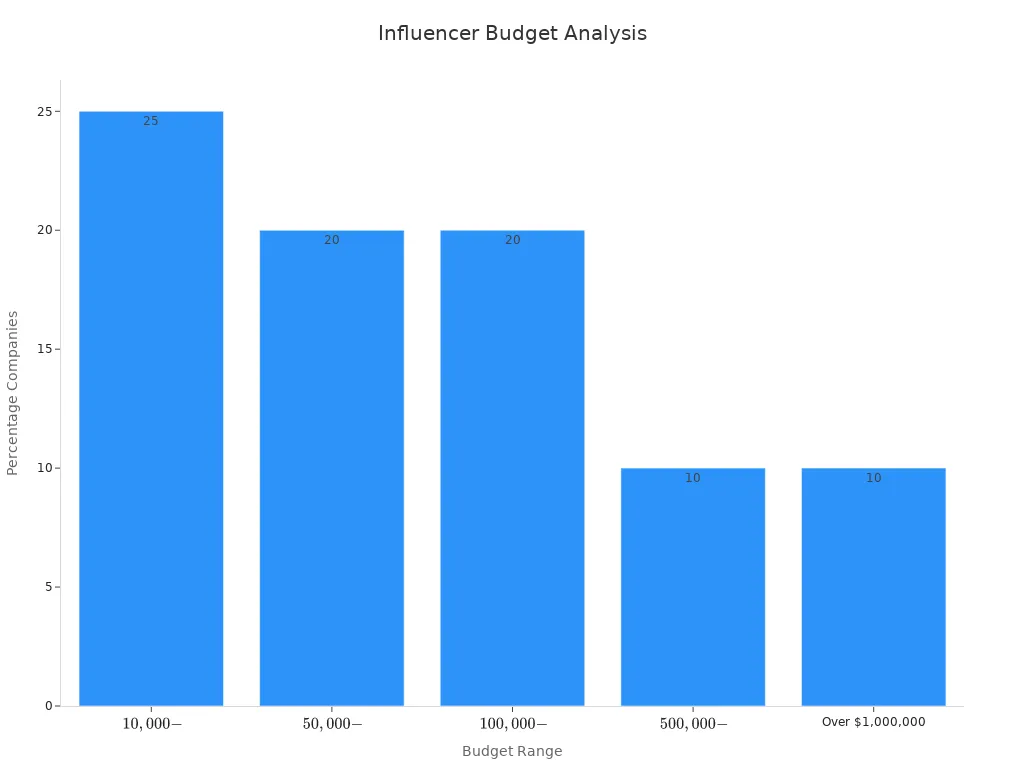
Mid-tier influencers: $500–$5,000 per Instagram post, $1,000–$10,000 per YouTube video
Macro-influencers: up to $25,000 per post
Mega-influencers: over $1 million per post
These high costs mean you must pick influencers carefully. You also need to watch your spending. If you do not, you might waste money on campaigns that do not work.
Cross-Border Barriers
Running influencer marketing in different countries is not easy. Every country has its own rules and culture. People use social media in different ways. What works in one place may not work somewhere else. You need to know these differences to do well.
The table below shows how influencer marketing is different around the world:
Region | Key Data Point | Implication for Cross-Border Challenges |
|---|---|---|
North America | Early adoption but requires tailored strategies for local markets | |
Europe | €3.375 million annual spend | Different spending scale and cultural preferences |
Southeast Asia | 41% CAGR growth in influencer marketing market | Rapid growth demands adaptation to emerging platform trends |
Spending, growth, and what people like are not the same everywhere. North America makes the most money, but you still need to change your plan for each place. Europe spends less and likes different things. Southeast Asia is growing fast, so you must keep up with new trends.
Instagram, TikTok, and YouTube help you reach people worldwide. This sounds simple, but it brings new problems. You have to learn what people in each country like. A campaign that works in the United States may not work in France or Indonesia. People in each country have their own habits and values. If you do not pay attention, your campaign might not work.
You also have to follow different rules in every country. Some places have strict laws about ads and sponsorships. If you break these rules, you could get fined or lose your audience. Language can be a problem too. You might need to translate your posts or work with influencers who speak the language and know the culture.
Tip: Work with local influencers or agencies. They know the market and can help you avoid mistakes.
Many brands hire agencies that know how to work in different countries. These agencies help you find the right influencers and make sure your message fits the local culture. They also help you keep up with new rules and trends.
To do well in cross-border influencer marketing, you must be ready to change. Study each place, listen to local experts, and change your plan when needed. This helps you build trust and connect with people everywhere.
AI-Powered Influencer Marketing
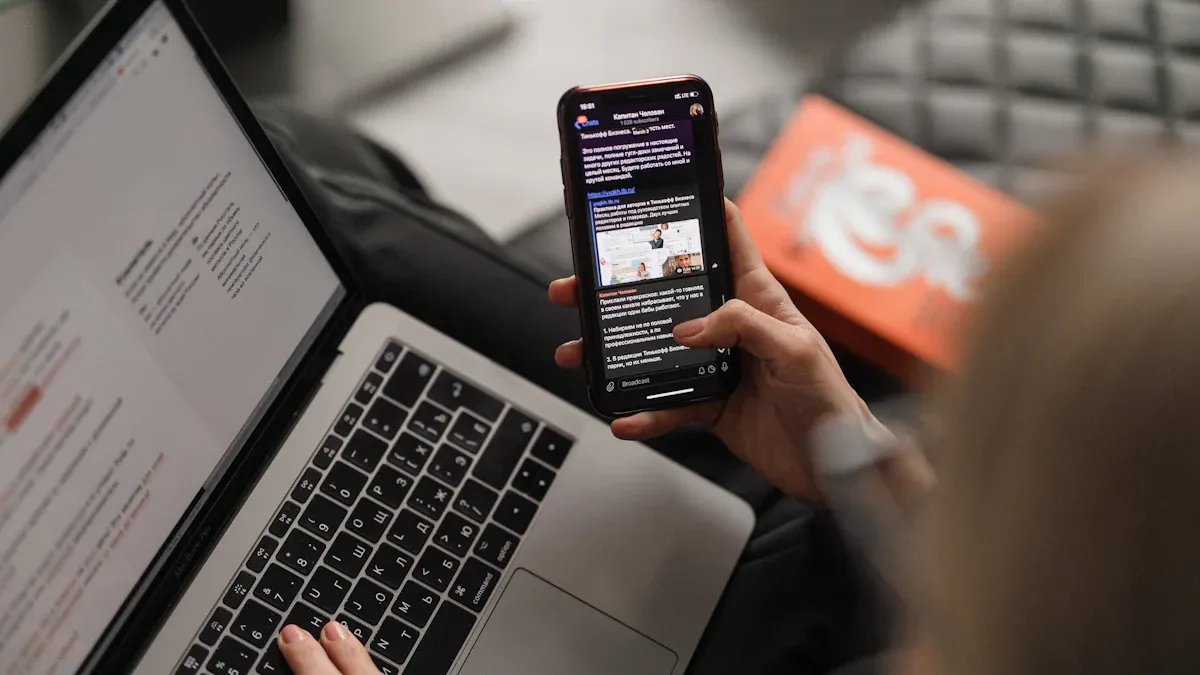
Data-Driven Strategies
You do not have to guess which influencer helps your brand. AI-powered influencer marketing uses real data to help you choose. These tools watch every click, like, and share. You can see how many people join your campaign. UTM links and special codes show sales and traffic from each influencer. This lets you know what works and what does not.
AI-driven analytics check important numbers over time. You can find patterns and change your plan fast. Many marketers use data to make content people like. This helps you get more engagement and reach your goals faster. AI also helps you spend money in smart ways. It shows which influencers give real results, so you do not waste your budget.
AI tools use UTM links and codes to track real engagement and sales.
Analytics help you pick content and channels by watching key numbers.
41% of marketers use data to make engagement better.
AI helps you choose influencers by checking engagement, audience, and fake followers.
Businesses using data-driven plans can get up to 8 times more ROI than others.
Evidence Category | Details |
|---|---|
Market Growth | Influencer marketing spend grew from $1.7B in 2016 to an estimated $13.8B in 2021. |
89% of marketers say influencer marketing ROI matches or beats other channels; $5.20 earned per $1 spent. | |
Consumer Behavior | 49% of consumers trust influencer recommendations for purchases. |
AI-Driven Influencer Matching | AI matches influencers to your audience by analyzing engagement, demographics, and style. |
Predictive Performance Modeling | AI predicts content success using past data and trends. |
Brand Compatibility Scoring | AI checks if influencers fit your brand values, replacing guesswork. |
Virtual influencers, powered by AI, give brands new ways to connect. These digital personalities do not have problems like scandals or sudden changes. Brands can keep their message the same and avoid issues that come with human influencers.
Transparency and Efficiency
AI-powered influencer marketing makes your campaigns clear and simple to manage. You can see each step, from picking influencers to checking results. AI tools look for fake followers and find fraud. They also make sure your posts follow all the rules. This lowers mistakes and keeps your brand safe.
You save time because AI does many jobs for you. Content approval, rule checks, and tracking happen faster. You can focus on planning while AI handles the small stuff. This gives you better results and less stress.
Measurable Improvement | Percentage / Impact |
|---|---|
Reduction in campaign execution time | 30% |
Increase in engagement rates | 50% |
Boost in conversions | 20% |
Improvement in influencer campaign ROI | 25% |
Reduction in non-compliance risk | 90% |
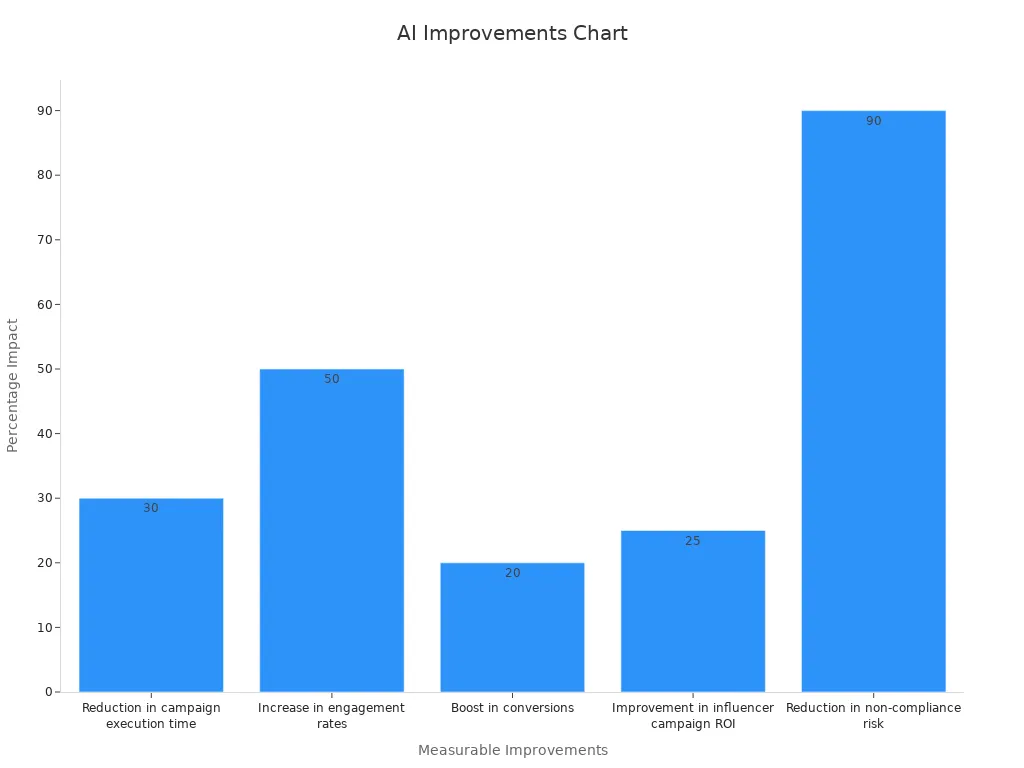
AI-powered influencer marketing helps you build campaigns that work again and again. You do not have to chase viral moments. Instead, you get steady, clear value from your work.
Market Trends
AI-powered influencer marketing is growing very fast. More brands use AI tools to find and work with influencers. The virtual influencer market is now worth $4.6 billion and grows by 26% each year. Many marketers want to use AI and machine learning to make campaigns better.
63% of influencer marketing professionals want to use AI and machine learning to improve campaigns.
49.3% of people like AI influencers, and only 10% do not.
AI tools help with finding influencers, checking fake followers, sending messages, and guessing campaign results.
Brands often use both AI virtual influencers and real people to get more reach and trust.
You can also use AI for making content and automating marketing. Almost half of marketers use AI to make content. About one-third use it for paid ads and emails. The AI marketing industry should reach $30.8 billion this year. Most businesses now use AI in their marketing.
32% use AI for paid ads and email campaigns.
64.7% of businesses have added AI to their marketing.
AI lets you send personal messages and guess what your audience wants.
AI tools do routine jobs, so you can focus on big ideas.
AI-powered influencer marketing helps you keep up with new trends. You can reach more people, work smarter, and get better results.
Define Goals
Audience Analysis
You need to know your audience before you start. AI tools help you learn who your audience is and what they like. You can use data to see which platforms your audience uses most. You can also find out what type of content they enjoy and when they are most active online.
To see if your campaign works, you should track important numbers. These numbers show if people see your content, talk about your brand, and take action. Here is a table with key metrics you can use:
Metric | Description |
|---|---|
Measures visits and page views, showing interest and awareness. | |
Brand Reach | Counts how many people see your brand across all channels. |
Referral Traffic | Tracks visitors coming from social media or blogs. |
Share of Voice | Shows your brand’s mentions compared to competitors. |
Earned Media | Counts media coverage or mentions gained without paid ads. |
Mentions | Tracks how often people talk about your brand and their feelings. |
Website Conversions | Measures actions like purchases or sign-ups from your website. |
Includes likes, shares, comments, follower growth, and video completion rates. | |
Brand Search Volume | Shows how many people search for your brand or related keywords. |
You should also check the average numbers for each social platform. Instagram and TikTok have different engagement rates and costs. Compare your results to your old campaigns to see if you are doing better. Using industry averages helps you set goals that make sense for your business.
Tip: Use tools like Google Analytics, Instagram Insights, and UTM codes to track these numbers easily.
Brand Alignment
Picking the right influencer is not just about big follower numbers. You want influencers who share your brand’s values and connect with your target audience. AI can help you check if an influencer’s style, tone, and audience match your brand.
Follower count alone does not mean you will succeed. Nano- and micro-influencers, who have fewer than 10,000 followers, often get higher engagement rates. For example, micro-influencers average an 8.21% engagement rate, while larger influencers average only 4.1%.
Look at engagement rates, audience demographics, and content trends. These numbers help you see if an influencer fits your brand.
Sentiment analysis shows if an influencer’s audience feels positive about your brand.
Being real matters. Influencers who share real stories build more trust. Over half of consumers trust first-hand product stories from creators.
Brands that let influencers use their own voice and creativity see better results and stronger loyalty.
You should set clear goals for your campaign. Decide if you want more brand awareness, higher sales, or more website visits. Use promo codes, affiliate links, and custom landing pages to track results. Consistent reporting helps you see what works best and plan future campaigns.
When you match your goals, audience, and influencer choices, your campaign has a better chance to succeed.
Discover Influencers
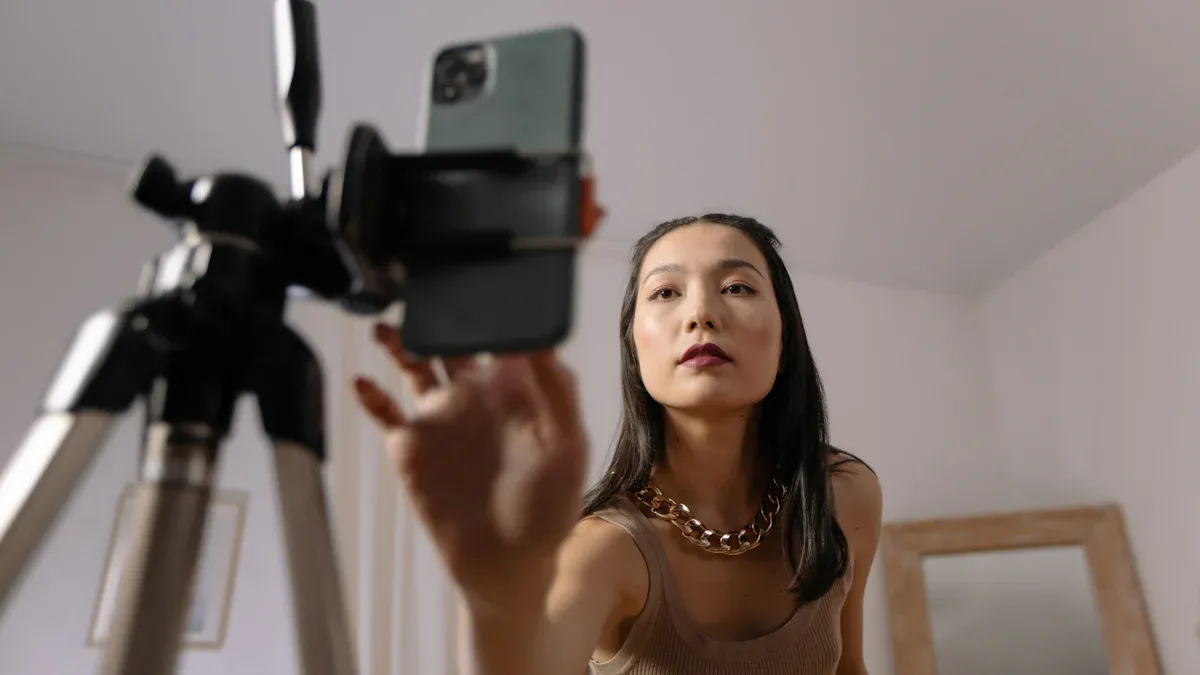
Automated Discovery
AI helps you find the right influencers much faster. Before, you had to look for hours and check each profile. You also had to send messages one at a time. Now, automated discovery platforms use AI to match you with influencers who fit your brand. These platforms look at millions of profiles using real-time data. They show you the best choices for your needs. You can filter by where people live, what they like, and how old their audience is. Some tools have more than 35 filters, so you can be very specific.
You do not have to worry about fake followers or losing money. AI-powered fraud detection looks for strange activity and makes sure you work with real people. Brands like HelloFresh used these platforms and got better results. They picked influencers who helped them sell more, not just those with lots of followers. This saves you time and helps you grow your campaigns fast.
Tip: Use platforms with dashboards in one place. You can track everything and see real-time analytics.
Here are some ways automated discovery helps you work better:
AI checks if influencers are real and if their audience is good.
You get detailed information about who follows each influencer.
Real-time data keeps your info current.
Automation does the research for you, so you do not need spreadsheets.
You can see clear ROI and campaign results.
Coca-Cola said they finished campaigns 30% faster after using AI-powered discovery. Many brands now get more engagement and more conversions because of these tools.
Predict and Maximize ROI
Performance Forecasting
AI lets you see how your influencer campaigns might do before you spend money. You can use predictive analytics to check old data and find patterns. This helps you pick influencers who will likely give you good results. AI tools watch important numbers like engagement, reach, impressions, and conversions as they happen. You can set alerts to know when something changes. This means you can quickly fix your campaign if things go down.
AI can guess which influencers will bring more sales or engagement. You do not have to guess anymore. You can use data to make smart decisions.
AI also tells you the best times to post and what topics to use. This helps you reach your audience when they are online. You can match your message to what your audience likes. This makes your campaign more likely to work.
ROI Analytics
You want to see if your influencer marketing is worth the cost. ROI analytics give you clear answers. You can track sales, conversions, and engagement to see what works best. Many brands use special discount codes, affiliate links, and trackable URLs. These tools show you how many sales come from each influencer.
Businesses earn about $5.78 for every dollar spent on influencer marketing.
Genomelink lowered customer costs by 73% with nano-influencers.
GreenPark got six times more daily app installs with targeted influencer content.
Hurom got 2.5 times more money back using macro and micro-influencers.
Influencer campaigns can give an average ROI of 520% when you use data-driven plans.
You can follow these steps to measure ROI:
Find Cost Per Acquisition (CPA) by dividing your total campaign costs by the number of conversions.
Use Customer Lifetime Value (CLV) to see how much money you get from each new customer.
Track how many customers come back and buy again with cohort analysis.
Use multi-touch attribution models to see how each influencer helps your customer journey.
Use real-time dashboards to watch your KPIs and focus on the best performers.
Measure SEO impact by tracking organic traffic and backlinks from influencer content.
If you spend $500 and make $2,000 in tracked sales, your ROI is 300%. This shows how tracking helps you see the real value of your campaigns.
Real-World Impact
AI-powered influencer marketing gives real results for brands. You can see big improvements in how fast you work, how much money you make, and how much you save.
Business Function | ROI Impact / Efficiency Gains |
|---|---|
Virtual Agents | |
CRM Automation | Personalized engagement and follow-ups |
Marketing Automation | 80% less content creation time; 45% more engagement |
Efficiency Gains | 40-80% less content creation time; 60% less admin work |
Revenue Impact | 25-45% more conversions; 35% higher customer value |
Cost Reduction | 40% lower operational costs; 25% less marketing spend |
GlamCo Cosmetics used AI to find top micro-influencers. They got a 7.2x return on ad spend and made influencers long-term partners.
ElectroHub picked mid-tier YouTube influencers with AI. Influencer referrals were 6.8 times more likely to convert, and the launch batch sold out.
AI marketing agents help you reach the right people and change your campaigns fast. Segmented campaigns can boost revenue by up to 760%. Predictive analytics can raise your marketing ROI by 20%. Automation also cuts marketing costs by up to 20%. You get more value, save time, and grow your business faster with AI-powered influencer marketing.
Outreach and Communication
AI Optimization
AI helps you reach influencers in a smarter way. You can use AI-powered tools to look at influencer data. These tools help you make content briefs just for each influencer. The briefs tell influencers about your brand and what you want. AI checks which content works best and gives tips right away. For example, Influencer Intelligence and Mavrck use machine learning to match your brand with the right influencers. They also help you come up with content ideas that your audience will like.
You can watch engagement rates and audience details with real-time analytics. Alert systems tell you if a post is not doing well. You can stop it or change your plan fast. AI finds posts that do better than you thought and tells you to spend more on them. This way, some brands saw 25% more engagement and 15% more conversions. AI makes your outreach work better and helps your campaigns get good results.
Tip: Use AI tools to do simple jobs like keyword research and social media scheduling. This gives you more time for creative ideas.
Automated Negotiation
AI helps you talk to influencers and make deals faster. You do not need to send lots of emails. AI-powered platforms suggest fair prices using influencer performance, audience size, and past results. These systems use data to pick contract terms and payment rates. You can see what fits your budget and goals.
Some platforms use chatbots to answer questions and handle easy talks. This saves time and stops mistakes. You can focus on building good relationships with influencers. AI also tracks contract details and deadlines, so you never miss anything important.
AI suggests fair rates with real data.
Chatbots answer simple questions and handle talks.
Automated reminders help you keep up with contracts and payments.
Localization
Localization means making your message fit different countries and cultures. AI helps by looking at language, tone, and trends in each place. You can use sentiment analysis to see how people in each country feel about your brand. AI tools help you find local influencers who know their audience well. This makes your campaigns feel personal and special.
Studies show that using AI for local campaigns can raise conversions by 10%. Micro-influencers, who work in local markets, get up to 60% more engagement than bigger influencers. People are 82% more likely to trust and follow advice from these local voices. You can see the impact in the table below:
Statistic | Description | Implication |
|---|---|---|
31% | U.S. adults influenced by social media influencers | Shows strong impact of localized influencer marketing |
3.8 million | Influencers in Brazil (15.8% of global share) | Highlights value of local influencer presence |
35.63% | Projected industry growth (2024-2025) | Shows expanding opportunities with localization |
60% higher | Micro-influencer engagement rates | Proves better audience interaction with local strategies |
82% | Consumers act on micro-influencer advice | Shows trust in local influencer communication |
When you use AI for localization, your campaigns feel personal and real. This helps you build trust and connect with people in every market.
Optimize and Monitor
Content Creation
AI makes content creation easier and more effective. You can use AI tools to suggest new ideas, write captions, and even create images or videos. These tools study what works best for your audience. They look at past posts, trending topics, and popular hashtags. You get suggestions that match your brand and speak to your followers.
AI can also help you keep your content fresh. It checks which posts get the most likes, comments, and shares. You can use this information to make more of what your audience enjoys. Some AI platforms even test different versions of your content. They show you which one gets better results.
Tip: Try using AI-powered content generators to save time and keep your posts interesting. Always review the content to make sure it fits your brand’s voice.
Timing Optimization
Posting at the right time can make a big difference. AI studies when your audience is most active online. It finds the best days and hours to share your content. This means more people see your posts and interact with them.
You do not have to guess when to post. AI tools look at your followers’ habits and suggest the perfect schedule. They also adjust if your audience changes over time. You can set up your posts to go live automatically at the best times.
Use AI scheduling tools to plan your posts in advance.
Check your analytics often to see if your timing still works.
Change your posting schedule if you notice a drop in engagement.
Real-Time Tracking
Real-time tracking lets you see how your campaign is doing right now. AI tools collect data every minute. You can watch likes, comments, shares, and clicks as they happen. This helps you spot what works and what needs to change.
Here is a table of important metrics to track in real time:
Metric Type | Description | Importance for Real-Time Tracking |
|---|---|---|
Quantitative Metrics | Reach, Impressions, View Rate, Engagement Rate (likes, comments, shares, saves), CTR, Conversions | Show how many people see your posts, interact with them, and take action. |
Qualitative Metrics | Audience Sentiment, Brand Mentions, Influencer Authenticity | Help you understand how people feel about your brand and if influencers are trusted. |
You should check your campaign performance daily or weekly. Use platform insights, third-party tools, or custom dashboards to gather data. Focus on both numbers and feelings. Look at impressions, reach, engagement rate, and sentiment. This gives you a full picture of your campaign.
Real-time tracking helps you adjust your strategy fast.
You can see which influencers bring the most traffic and sales.
Tools like Scaleo, Grin, Klear, InsightIQ, and Google Analytics make tracking easy.
Detailed reports show your ROI and help you make smart decisions.
Real-time insights let you spend your budget where it works best.
Tip: Always align your tracking metrics with your campaign goals. This helps you measure success and improve future campaigns.
AI-powered influencer marketing helps you run campaigns faster and better. These tools make it simple to see what works and avoid mistakes. You get clear data to help your brand grow. As your brand gets bigger, your campaigns can grow too. Try using AI-powered platforms or ask experts for help. This will help you stay ahead and get strong results that last.
FAQ
What is AI-powered influencer marketing?
AI-powered influencer marketing uses artificial intelligence to help you find, choose, and work with influencers. AI checks data, spots fake followers, and shows you what works best. You get better results and save time.
How does AI help you find real influencers?
AI tools scan profiles for real engagement and audience quality. They spot fake followers and bots. You can trust the influencers you choose because AI checks their history and activity.
Can AI improve your campaign results?
Yes! AI tracks your campaign in real time. You see what works and what does not. You can change your plan quickly. This helps you get more likes, shares, and sales.
Is AI expensive to use for influencer marketing?
Many AI tools offer free trials or low-cost plans. You can start small and grow as you see results. AI helps you save money by picking the right influencers and avoiding fake engagement.
How do you measure ROI with AI?
AI tracks every click, sale, and mention. You see which influencers bring the most value. Use dashboards and reports to check your return on investment (ROI) easily.
Does AI replace human creativity in influencer marketing?
No. AI gives you data and suggestions, but you still make creative choices. You work with influencers to create content that fits your brand. AI helps you focus on ideas, not busy work.
Can AI help with global influencer campaigns?
Yes. AI tools help you find local influencers, translate content, and understand cultural trends. You reach people in different countries with messages that fit their needs.
Tip: Always review AI suggestions before posting. Make sure your content matches your brand’s voice and values.
See Also
How To Easily Calculate Influencer Marketing ROI Today
Reliable Strategies To Increase Influencer Marketing ROI 2025
Best Ways To Boost Influencer Marketing ROI This Year
